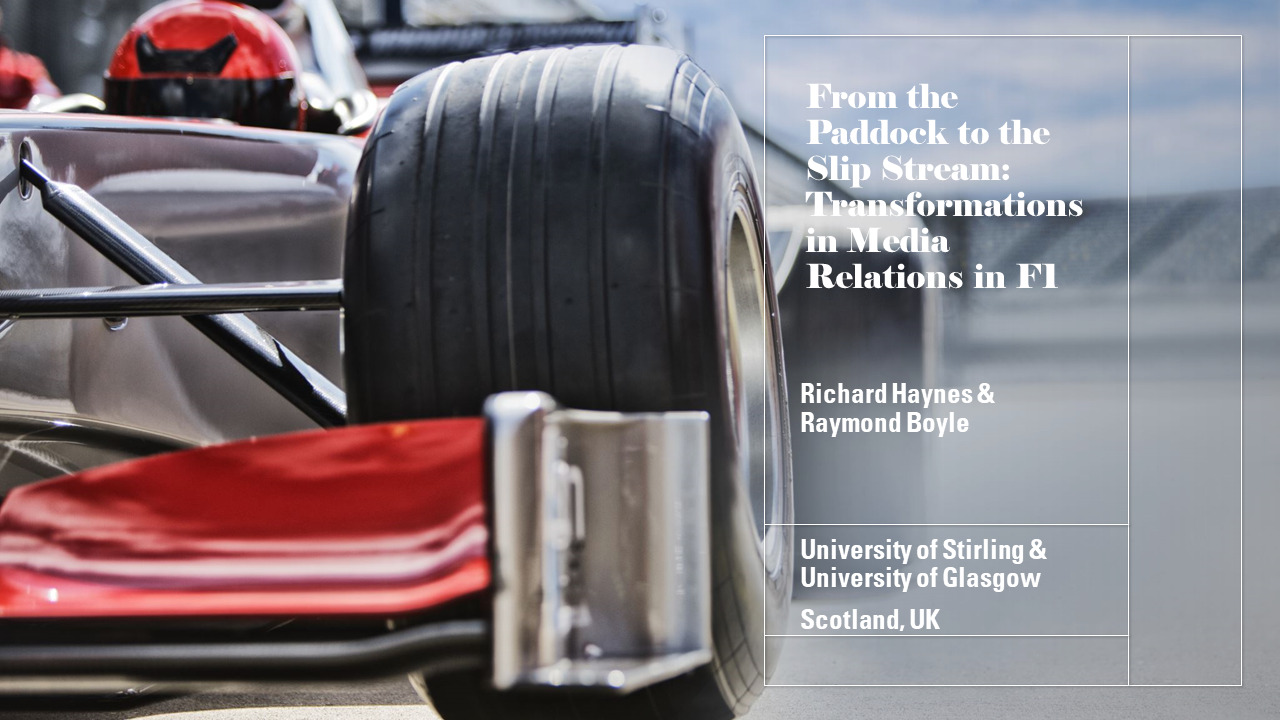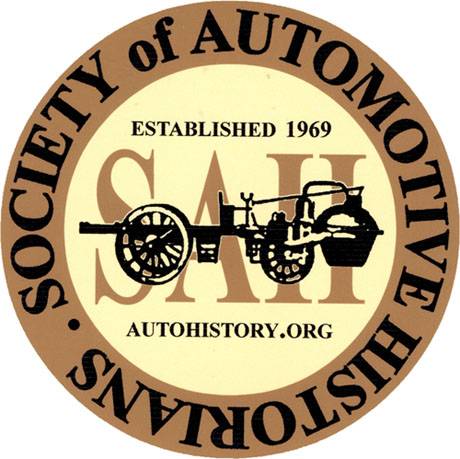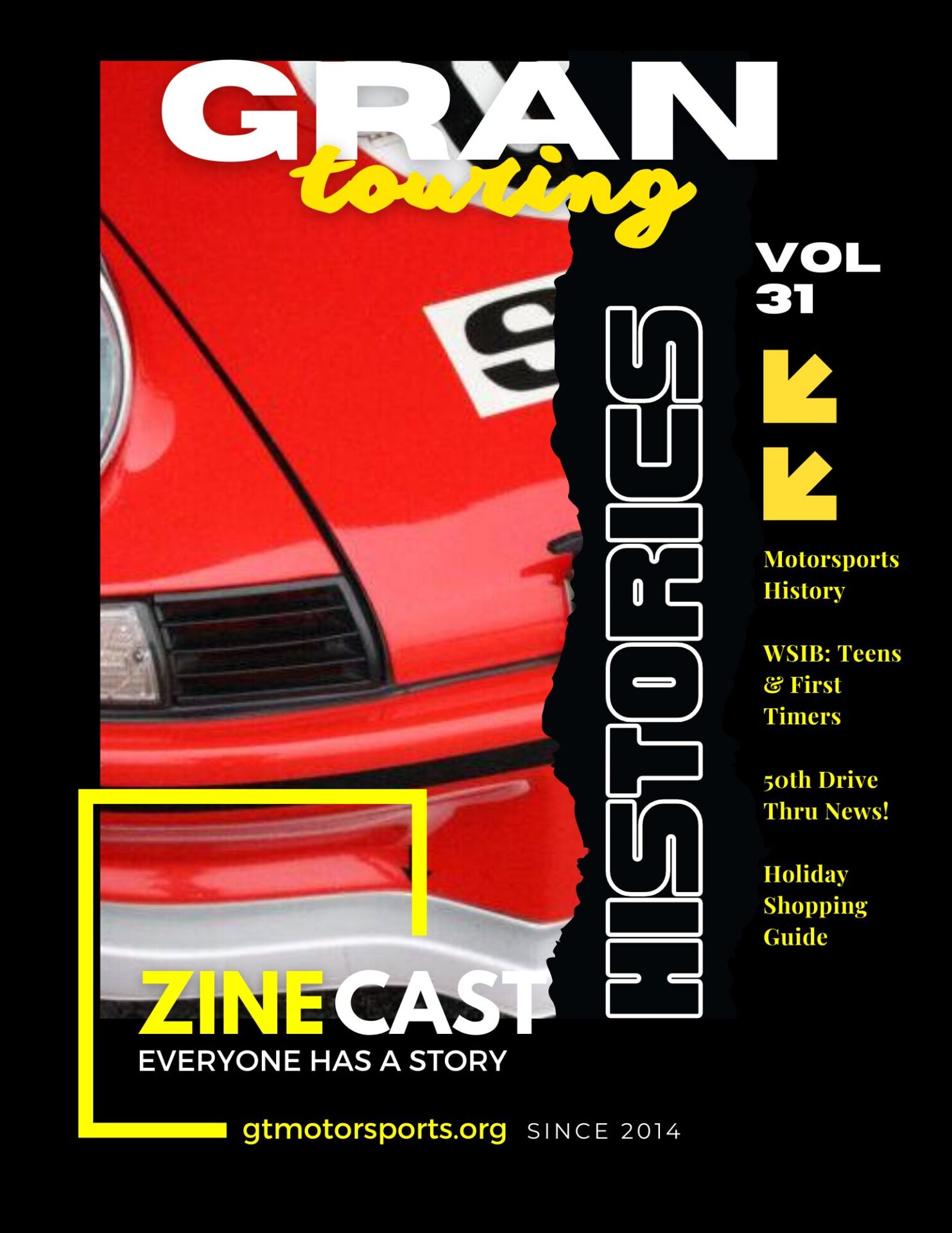Based on archival and biographical research and interviews with British journalists, broadcasters and communications managers, this presentation provides an analysis of the transformations in media relations in Formula One from 1960s onward. The paper explores the professional careers of leading British journalists and broadcasters of F1 to explore how media relations have changed over time. We conclude with some thoughts on how F1 in the era of Liberty Media, is bringing new opportunities for F1 across different platforms, transforming again the media relations of the sport.
Tune in everywhere you stream, download or listen!
 |  |  |
- Bio
- Notes
- Transcript
- Livestream
- Learn More
Bio

Richard Haynes is professor of Media Sport in the Division of Communications, Media and Culture at the University of Stirling, Scotland. He is author of seven books on sport and communications including the award-winning history BBC Sport in Black and White (Palgrave 2016) and his forthcoming book with Raymond Boyle Streaming the Formula 1 Rivalry: Sport and the Media in the Platform Age to be published by Peter Lang in 2024.
Notes
Transcript
[00:00:00] Brake Fix’s History of Motorsports series is brought to you in part by the International Motor Racing Research Center, as well as the Society of Automotive Historians, the Watkins Glen Area Chamber of Commerce, and the Argettsinger family.
From the paddock to the slipstream, transformations in media relations in Formula 1. By Richard Haynes. Richard Haynes is Professor of Media Sport in the Division of Communications and Media Culture at the University of Stirling in Scotland. He is author of seven books on sport and communications, including the award winning history BBC Sport in Black and White, published by Palgrave in 2016, and his forthcoming book with Raymond Boyle, Streaming the Formula One Rivalry, Sport and the Media in the Platform Age, to be published by Peter Lang in 2024.
Based on archival and biographical research, the interviews with British journalists, broadcasters, and communications managers, this presentation provides an analysis of the transformations in media relations in Formula One. From the 1960s [00:01:00] onward, the presentation explores the professional careers of leading British journalists and broadcasters of Formula One to explore how media relations have changed over time.
We conclude with some thoughts on how Formula One, in the era of Liberty Media, is bringing new opportunities to F1 across different platforms, transforming again the media relations in the sport. So my talk is based on a book which I’ve just written with my colleague, Raymond Boyle. The talk is really about the changing, Relationships between journalists and Formula One, that’s the focus of our book.
I’m mainly going to talk about the kind of historical aspects of that, but also point towards some of the contemporary issues that this has raised. We researched the book doing interviews. We interviewed journalists, both contemporary journalists and journalists that have been in F1 or motorsport journalism for many years, many decades in some cases.
And we also spoke to broadcasters, and we spoke to communications managers who work in F1. And one of the reasons we wanted to do this was because neither Raymond or I would say we’re experts in [00:02:00] motorsport by any means, but we’re both your average fan, I guess, of F1 for many years. But what we noticed as researchers of the relationships between media and sport, that F1 is delivering something different, new in this relationship, and it may be signposts to where other global sports may be heading in the future.
And that was one of the reasons why we were intrigued. To explore this with journalists, with broadcasters, with the comms people from within that industry and see what they thought was going on. Because definitely things have changed in that sport quite radically, certainly since Liberty Media took over, of course, that was one reason for writing the book.
The other really is to look at how the media ecology of sports changed. So we placed the contemporary media relations in a broader historical context. We identified the central role that the media, particularly television, played. And it’s placed in the history structure and the governance of the sport.
Bernie Eccleston’s been mentioned various times and he’s had his fair share of run ins with the law and governance throughout his reign in Formula One. [00:03:00] For a used car salesman who, uh, is recently found guilty of tax fraud. Certainly, you know, he made, obviously, Formula One a very intriguing and lively and a kind of business that it has become.
But arguably it’s moved on from his reign in tune. And I’ll talk a little bit about how in Eccleston’s period, the media. Bill, a certain type of media relation within the sport, which was again, was maybe unique and a sport enters into a kind of digital age of engagement of seeing things like tick tock and so on are just a wash with content to do with formula one, that intense relationship between F1 and the creative industries not only shows us something about where the media are changing, but also How we understand what even the term sport or motorsport means, because I think there are aspects of how the sport is changing because of the media, which again are intriguing and tell us something a bit different about our relationship with it.
So those are the reasons why we wrote the book. But first, my historical journey about the sport. Formula One begins with Murray Walker. He was BBC and then ITV [00:04:00] commentator, or announcer, as you’d call here, for many years. For somebody of my generation, Murray Walker was synonymous with motorsport and Formula One.
His voice, I mean, I can hear it now, it’s quite a high screech. Somebody said it was like a 500cc motorcycle, kind of high pitched, kind of rev, um, and he spoke that quickly as well. All of his commentaries, he was stood up because his adrenaline and his excitement at motorsport just came through the microphone.
Now no longer with us, he died in 2021. But when I was researching another book on the history of BBC sport over a decade ago now in 2008, had the pleasure of interviewing Murray, which again was a kind of interesting experience. Murray’s professional career was not in broadcasting at all. It was in advertising.
It was involved in the second world wars. He drove tanks. He was in the tank regiment. As he left, he joined the advertising industry. Obviously you would have heard of Mars chocolate. He ran the account for the ad campaign, which went a Mars a day helps you work, rest and play. And he was in charge of that.
It’s a very famous slogan from advertising from the [00:05:00] 1970s. And Murray was involved in that, but he did commentary part time. When I interviewed him, he said, if you ask me, how did I get into broadcasting? He said it was nepotism. My dad and his dad, Graham was a radio commentator in the 1930s for the BBC and also raced motorbikes.
And it was that passion for motorbikes that mainly led Morita to get into broadcasting. So he did it part time. But one of the most interesting things he said to me, to quote in there, he said, I believe motorsport needs explaining more than other sports. Partly because most people haven’t done it.
Whereas with most other sports, they have done it. Whether it’s cricket, football, soccer, tennis, most people at a participatory level have played these sports, but motorsport is different. Most people haven’t done it. And partly because also the equipment itself, the technical aspects of the cars or the motorcycles.
It’s an interesting quote because I think that still resonates today, doesn’t it? Most people have never raced cars and certainly most people have never sat in an F1 car. So the job of the broadcaster to explain what’s going on [00:06:00] is quite a difficult one. In a sense for us, the audience to pick up on that.
And that plays through into some important aspects of how television in particular works in its coverage of motorsport and F1. And why in the 1970s that again, we’ve heard the name James Hunt mentioned and Murray Walkers commentated with James Hunt. He very quickly became a kind of the analyst for the BBC coverage of Formula One in the 1970s and also people like Jackie Stewart as well.
And today for Sky Sports, Martin Brundle is probably the most well known ex driver that does. Broadcasting for F1 British television. But for all the journalists, broadcasters and communication professionals, we interviewed the route to becoming an F1 journalist involved elements of luck and happenstance really was the professional journey into F1 journalism by design or straightforward.
Rather journalists followed their instincts of the kind of career that they wanted and develop their craft of journalism and move quickly. An opening appeared into their chosen career. And another good example of [00:07:00] that, apart from Murray’s, I guess, is uh, Morris Hamilton, again, a well known motorsport journalist, but also author from Ireland.
He explained that as a young man in Ireland, he was very passionate about motorsport and just wanted to get some association with it, to be on the track, at the side of the track, to see his heroes. And so he wrote just randomly as a young man to a guy called Ian Young, who was a columnist for Autocar.
But also a friend of Bruce McLaren and had strong associations with the McLaren team. And for whatever reason, Ian Young said, well, come over to Britain. And he took him under his wing. He basically, Hamilton was kind of held onto his coattails. sideman of coverage and interviews around motorsport and F1 again, in particular, and introduced Hamilton to the kind of top tier, to the team managers, to drivers, sponsors, and so on at a very early age.
And he said, He was incredibly lucky. It just happened to be at the right time, the right place. Probably his face just fitted for whatever reason from that very early experience in his early twenties and having that network very [00:08:00] early in his career was able then to become the Guardian’s motorsport correspondent in the 1970s and then has gone on still is reporting on motorsport decades later.
One of the interesting things about motorsport when generally you look at it. In terms of its relationship with the media is the longevity of some of the publications within it and some of the journalists that have had really long careers in association with Formula One. Again, some years ago, I was asked to do a Oxford Dictionary and National Biography entry for a guy called Bruce.
Bill Body who’s uh, and Bill Body was the editor of Motorsport from 1936 to 1991, and he continued to write for the magazine until his death in 2011. That was an 81 year career as a journalist in Motorsport. And at the time, he was not only the longest serving editor in the British media, but I think the longest serving journalist nonstop in the world.
81 years, which is quite incredible. So Boddy was by far and away, you know, one of the more fascinating characters that I’ve come across from the world of [00:09:00] motor sport journalism. His career began when he visited Brooklands as a young man or a young boy in 1926. And he published his first article on the history of the Brooklands motor track in 1930.
Boddy developed a career as a freelance motor journalist, and after a brief spell working in a motorcycle shop, his first editorial role came in 1933, as the editor of Brooklyn’s Track and Air, for which he also road tested new cars as a passenger because he hadn’t passed his driving test. The image of a Grand Prix racing has also been key to our popular imagination of the sport.
The brand of Ferrari, for example, is heavily linked to the rise of sport photojournalism in the 1960s. Italian photojournalist, Franco Linney was one of the first journalists to travel to all Grand Prix races around the world. Reporting for the Journal Auto Italiana, Enzo Ferrari was so impressed with Lynn’s knowledge, his contacts, his multilingual capabilities.
He offered him the job of team manager [00:10:00] in 1966 and helped. In the changing of, again, we heard about the image of motorsport and the image of the Scuderia from that period. The brand and the imagery that goes with Ferrari really all links back to the work of Franco Lini and a lot of his photographs from the fifties and sixties.
We interviewed a number of former editors and photographers of motorsport magazines who’d followed in the footsteps of Boddy and Linney. This included people like Matt Bishop, who latterly was the comms manager for Aston Martin F1 team, but previously had spent nearly 30 years as a journalist and editor of F1 Racing, which then became GP Racing, now part of the Motorsport Network.
And he remarked about the importance, uh, as a young boy, Passionate again about soccer, and he had a subscription to a soccer magazine, but going in to collect it one day, he saw a copy of Autosport on the shelves. It’s just intrigued again. I think it was a, an amazing image of an F1 car on the front. His fascination got the better of him.
He changed his [00:11:00] subscription from a soccer magazine to a motorsport magazine, and the rest is history. From that point on, all he wanted to do again was get to get close to the drivers, get close to the cars and develop a career in the business. I suppose one of the things to say, finally, about the longevity of some of these titles is that, obviously, they’ve had to change as the media ecology has changed.
So, obviously, Motorsport is not only a magazine in print, it’s a website, it works across different platforms, it does video, it does podcasts, it does lots of social media as well. So, again, how the longevity of Motorsport magazines has changed over time has had to change with the technology. that delivers them and how people want to read them.
The history of broadcasting in F1, and again, forgive me, the focus here really is on the UK. Different nations have different kind of broadcasting histories around sport, not least in the United States. Britain has a quite distinct, I would say, history of broadcasting sport, and particularly motorsport.
And that’s mainly because the BBC itself continues to be publicly funded through a license fee and doesn’t take advertising, [00:12:00] although I know if you watch BBC America here, you’ll see lots of advertising. But in the UK. Still, there’s no spot advertising between programs on the BBC, even though it arguably works more and more as a commercial type broadcaster in many ways.
The first notable radio broadcast on the BBC on the subjects of Grand Prix racing was in August 1926, in a 30 minute talk entitled, The Brooklyn’s Grand Prix by the Engineer and Journalist and Motoring Enthusiast. Mervyn O’Gorman, and the talk was broadcast on the eve of Britain’s first Grand Prix on the 7th of August, 1926, at Brooklyn’s racetrack.
On the 1st of October, 1927, the BBC carried its second eyewitness report of the second British Grand Prix, also from Brooklyn’s. And on this occasion, the BBC turned to a racing driver called Sammy Davis to provide The account of the race. Davis had not long returned from winning the 24 hour race, but was also the sports editor of the magazine AutoCar and was therefore viewed as someone with both a [00:13:00] sporting and journalistic credibility.
And I think one of the interesting things about broadcasting in particular, and the challenge that sport broadcasters have had ever since the medium was invented was. Announcers have to have that skill of being a broadcaster, of kind of being mellifluous, of being able to speak to an audience and explain what’s going on, and balance that out with being an expert in the sport.
Quite often, or increasingly, I would argue that those two roles are kind of split now. Obviously, we have an announcer that does the play by play commentary of explaining what’s going on, sat next to or alongside an expert, a former player. Or former motor racing driver in the case of F1. That’s the challenge of broadcasting commentary and announcing is that balance between expertise in the sport and being an expert broadcaster.
And so we see early examples of the BBC trying to do that with Sammy Davis being a driver, but is also just happened to be a journalist as well. It was not until 1950 that the BBC found its main voice of motorsport with a guy called Raymond Baxter. Again, a long standing [00:14:00] broadcaster in the UK. What’s quite interesting about this period, all these guys were involved in the war in some shape or form.
Baxter was a fighter pilot in the Second World War, but also spent some time working for British Forces Network radio in Hamburg during his time in the forces. He entered the BBC as their first motoring correspondent in 1946. He worked across radio and television, not only active as a broadcaster, but also as a motor racer himself.
He competed in 12 Monte Carlo rallies and quite often did radio reporting as he was doing the, the racing. One of the interesting asides about the BBC and the Monte Carlo rally. As in, I think nine, I might say in 1958, they entered a London taxi to the Monte Carlo rally from Glasgow to Monte Carlo. One of the doors fell off as they got on the ramp to go on the ferry across to France.
So they did most of the race without one door. And then they also went missing. So the BBC had put journalists all around the, you know, along the course or the route. The driver, a guy called Tony Brook [00:15:00] decided, well, there’s no way I’m getting a London taxi, you know, around the central massif of the mountainous area of central France.
So I’m going to go round the flatter course, but the BBC had put Posted one of its journalists at the top of the mountains and they were waiting and waiting and waiting for this car never arrived And so they posted back to London to say we think he’s crashed He’s disappeared and it wasn’t until he turned up in Monte Carlo that they actually realized he was still alive And he got a rollicking by all accounts by the producer for changing his route The London Times had headlines of BBC taxi disappears in the mountains of France But partly because of the challenges, I guess, of covering motorsport was one of the reasons why between the 1950s and 1970s, there really wasn’t much Formula One racing on television.
There was a bit of film coverage. BBC did show quite a bit. Again, one of the producers of BBC Sport in this period in the fifties and sixties said to me, they used to buy film from America. of crashes and their editor used to just put them all together in a two minute sequence of just lots of car [00:16:00] crashes, whatever sort of track it was from the States.
They thought the audience found that entertaining for whatever reason. I guess that’s one of the appeals maybe of the jeopardy of motorsport on TV, but let’s think of a sport like boxing, for example, that’s relatively straightforward to cover because it’s what you might call maximum action in a minimal space.
Whereas motorsport, well, it’s maximum action, but it’s in a really expansive terrain. You know, trying to cover that on television or on radio is a logistical nightmare. It’s a real challenge, even to this day, arguably. So you can post cameras all around a track, but how you make sense of that for the audience is really difficult.
And that was one of the reasons really why motorsport didn’t take off on television in the UK, certainly in this period, because it was either too expensive to do that or hadn’t figured out what the best way of doing it was. So during the early 1950s, Baxter persuaded the BBC also to create its own motorsport events.
So one of the interesting things is hill climbs was a big thing in the UK from the 1920s onwards. And just after the war, Baxter came up [00:17:00] with a new competition called the BBC Television Trophy. And him and a producer came up with a bespoke track just north of London. So it was easy to get, again, the outside broadcast.
cameras there, they set the course so that they could strategically place the cameras in the right places and so on. This lasted for about seven or eight years, and one of the interesting things about it is the trophy there. That is a, what’s called an image orthicon camera, which was the main camera that the BBC then used in the 1950s.
And so they had an artist design that trophy that looked like the camera, and that was first used as a motor racing trophy. But from 1954. The same trophy was also used for what’s called the BBC Sports Personality of the Year, which still continues to this day. It’s one of the most prestigious awards sports people in Britain receive from the viewers.
So viewers vote for who they want to win that trophy. And in 1961, we’ve got Sterling Moss receiving it. So again, the lineage of a kind of major Sporting Award has its links back to the BBC trying to create a motorsport [00:18:00] event for its cameras for itself that it knew it would cover. So it’s a nice kind of link back, I guess, to that early history of how broadcasting of motorsport began on the BBC.
It’s also interesting to note that Formula One drivers or motorsport drivers more generally have won that trophy on eight occasions, which is only surpassed by athletics. Many people would argue that football, soccer is the biggest sport in the UK, but in terms of that trophy. It doesn’t equate, it doesn’t link.
And I think partly one of the reasons for that is that motor racing drivers just have that kind of hero factor. You know, they’re risking their lives. They just become kind of heroic figures like Sterling Moss. So the winners include Sterling Moss, John Surtees, Jackie Stewart, Nigel Mansell. Damon Hill and Lewis Hamilton, and in fact, Hill and Hamilton have won it on more than one occasion.
So the success of that award, and the success of F1 drivers in that award, is maybe suggest a signpost to the broader cultural appeal of F1 to the British public, even though in the, like I say, the 70s, they didn’t [00:19:00] really see very much action of drivers at all, but they continue to be worshipped, I guess, as key sporting heroes within British popular culture.
Okay, now the Eccleston part. Bernie recently, uh, found guilty of tax fraud at the grand old age. I think he’s now about 96 or something, certainly in his 90s. But for many years, obviously the extrovert, controller, owner, commercial entrepreneur of Formula One. One of the interesting things in talking to the journalists was what they perceived was the relationship or the access that journalists had during the Eccleston era.
And I think to sum it up is basically that Eccleston just Loved newspaper coverage, whether it was good, bad, or indifferent, he didn’t really care. But if F1 or his name was in the papers, that’s all he was interested in. So it didn’t have to be a good news story, it could be a bad news story. But it was just getting the visibility of F1 out there.
He liked to be controversial. I think Rebecca Clancy, who’s one of the few female F1 journalists of the times, she said, Bernie’s creating headlines. In F1, it was known as [00:20:00] throwing a grenade. So he was well known for throwing a grenade all the time, I guess, to get in the news. The ability to more or less get access to all areas of the racetrack is one of the major differences of the late 20th century compared to how things developed once press officers and communications managers came into the sport.
Again, to quote Morris Hamilton, he said, It was very open and you were on good terms with everybody. You could chat away as they walked along the pit lane. You could talk anytime you liked. Similarly with team owners, Colin Chapman, less so because he was God and I was terrified of him. But people like Ted Mayer, McLaren, Ken Turrell, for example, you could go and chat to Ken anytime about any topic on anything.
And Hamilton also talked about a time where journalists. Would turn up at driver’s motorhome and just huddle around a table asking questions. He mentioned James Hunt again was one of the key characters that you could just roll up and just ask him questions and they would use those stories as the follow ups for their Tuesday edition.
So Monday was for [00:21:00] reporting on the weekend racing, um, you know, the factual aspects of what happened on the race, but Tuesday was the follow up of the kind of different kinds of angles and stories. So he said, we all had different thoughts, and so it was really quite good. You recall. The tabloids would have their different line and they were reporting on kind of personal angles of the drivers.
I might be more interested in how the chassis setup works or some of the technical details. So he worked to build the relationships with mechanics who would provide insights on how cars were performing and in particular cars were running. And he said, now there’s security, you can’t get close to them.
They’re not allowed to talk to you. They’re scared and terrified of breaching their protocols. So I think one of the key things that start to come out of the conversations we were having with journalists was particularly the ones like Morris Hamilton, who’d been doing it for decades, was since Eccleston finished then Liberty Media took over, is far more control about how the media relations work and the access that they have into the pit lane and with drivers, which is far more kind of controlled and timed on particular days and at [00:22:00] particular times.
What that’s created is, of course, our kind of media hierarchy, so it’s no surprise because television broadcasters pay the lion’s share of the income that F1 receive. I think Sky Sports, which is the main broadcaster of F1 but also in Germany, Italy, I think, Think Spain, they are literally one of the largest commercial sponsors of F1 at the moment because the amount of money they pay in rights.
So there’s no surprise that they get first access and incredible access really around the paddock. You know, we’ve got Martin Brule there talking to Brad Pitt, and again, this pre-race walkthrough and walk around has become synonymous with the house sky cover of the sport. Martin Brundle is the one that leads that.
We’re talking about the image of the sport rubbing off of celebrities that are also there in the pad. But you won’t find one single journalist on pit lane. They don’t have that access. They’re back in some media center somewhere watching it unfold on the screen. Whereas broadcasters, they’re there on the ground getting really intimate coverage, interviewing drivers if they’re prepared to talk before the race.
[00:23:00] Sports writer, Richard Williams, again, who wrote a fantastic book, Racers, which is about the 1996 season when Damon Hill won the championship. And a great insight into, again, how one season unfolds and the narrative unfolds around a story. He argues that then, so again, we’re going back to the 1990s and until maybe 10 years ago, I would say that television provided the images, but it was the tabloid newspapers that provided the stories for the British public around F1.
So for a good 20, 30 years, newspapers. Remain important for telling the stories for the angles for celebrity culture around sport and some of the scandal, of course, around the sport, but he argues that that’s now changed. Newspapers just don’t have that leverage anymore. And another interviewee, Andrew Benson from the BBC sport online, he acknowledged that broadcasters are definitely ranked higher than the written media and where there is high demand for interviews and drivers are selecting who to talk to.
It. They will always go to broadcasters first. They will not choose a journalist, even an online [00:24:00] journalist for a reputable organization like the BBC, they will skip the overlook those and go to the, uh, the main broadcaster. So fundamentally they’re using the media to expose their brand. He said, as they see it, which is part of the complications of the job from the media’s perspective.
So you can understand. Why they’re going to rank the importance of outlets as far as they’re concerned. What happened in there with the quality of access dictates really both the ranking order, but also the quality of the media representation that any particular outlet can produce. And so that’s continues to be a major struggle for what we might call traditional journalism.
So, to finish off, one of the things, again, no surprises really, as the media ecology has changed. The most significant shift in the media relations has been caused by social media. Many journalists noted frustration with how drivers and teams released information on social media. Usually Twitter or X or Instagram that stands as the final communication on particular events and Lewis Hamilton has done this on numerous occasions where if he wants to get a message across [00:25:00] he’ll use his social media but he won’t talk to a journalist he’ll just say a question about whatever the matter is arises he says just go and look at my social media there’s my answer.
So when questioned further on the information released on social media drivers are reluctant. To expand on the detail, preferring to let their comments and images posted on social media stand as the final point of communication. Long time journalist and author, Morris Hamilton, again, believes this has changed everything.
And Rebecca Clancy of the Times argues that when drivers have their own media outlets, why do they need to talk to us? So, to conclude, we would argue that the rise and importance of social media in the last decade or so has cut across the value of traditional news media and accounts of the race. By the time the newspaper hits the shelves, or even the website, the main story of the race has been told and covered on multiple channels, broadcasters and social media, with multiple perspectives.
from different commentators. This has changed the dynamic and become the key factor in both policing behavior but paradoxically allowing drivers to take greater control of [00:26:00] the narratives that surround them. In so doing, it has allowed the drivers and the teams to reach out to a wider audience, many of whom simply do not read newspapers anymore.
This episode is brought to you in part by the International Motor Racing Research Center. Its charter is to collect, share, and preserve the history of motorsports, spanning continents, eras, and race series. The center’s collection embodies the speed, drama, and camaraderie of amateur and professional motor racing throughout the world.
The Center welcomes serious researchers and casual fans alike to share stories of race drivers, race series, and race cars captured on their shelves and walls and brought to life through a regular calendar of public lectures and special events. To learn more about the Center, visit www. racingarchives.
org. This episode is also brought to you by the Society of Automotive Historians. They encourage research into any aspect of automotive history. The SAH actively supports the [00:27:00] compilation and preservation of papers. Organizational records, print ephemera and images to safeguard, as well as to broaden and deepen the understanding of motorized, wheeled land transportation through the modern age and into the future.
For more information about the SAH, visit www. autohistory. org.
We hope you enjoyed another awesome episode of Brake Fix Podcast brought to you by Grand Touring Motorsports. If you’d like to be a guest on the show or get involved, be sure to follow us on all social media platforms at GrandTouringMotorsports. And if you’d like to learn more about the content of this episode, be sure to check out the follow on article at GTMotorsports.
org. We remain a commercial free and no annual fees organization through our sponsors, but also through the generous support of our fans, families, and friends through Patreon. For as little as 2. 50 a month, you can get access to more behind the scenes action, [00:28:00] additional Pit Stop minisodes, and other VIP goodies.
As well as keeping our team of creators fed on their strict diet of fig Newtons, gumby bears, and monster. So consider signing up for Patreon today at www. patreon. com forward slash GT motorsports, and remember without you, none of this would be possible.
Livestream
Learn More
 If you enjoyed this History of Motorsports Series episode, please go to Apple Podcasts and leave us a review. That would help us beat the algorithms and help spread the enthusiasm to others. Subscribe to Break/Fix using your favorite Podcast App:
If you enjoyed this History of Motorsports Series episode, please go to Apple Podcasts and leave us a review. That would help us beat the algorithms and help spread the enthusiasm to others. Subscribe to Break/Fix using your favorite Podcast App: |  |  |
Consider becoming a Patreon VIP and get behind the scenes content and schwag from the Motoring Podcast Network
Do you like what you've seen, heard and read? - Don't forget, GTM is fueled by volunteers and remains a no-annual-fee organization, but we still need help to pay to keep the lights on... For as little as $2.50/month you can help us keep the momentum going so we can continue to record, write, edit and broadcast your favorite content. Support GTM today! or make a One Time Donation.
This episode is sponsored in part by: The International Motor Racing Research Center (IMRRC), The Society of Automotive Historians (SAH), The Watkins Glen Area Chamber of Commerce, and the Argetsinger Family – and was recorded in front of a live studio audience.
Other episodes you might enjoy
Michael R. Argetsinger Symposium on International Motor Racing History
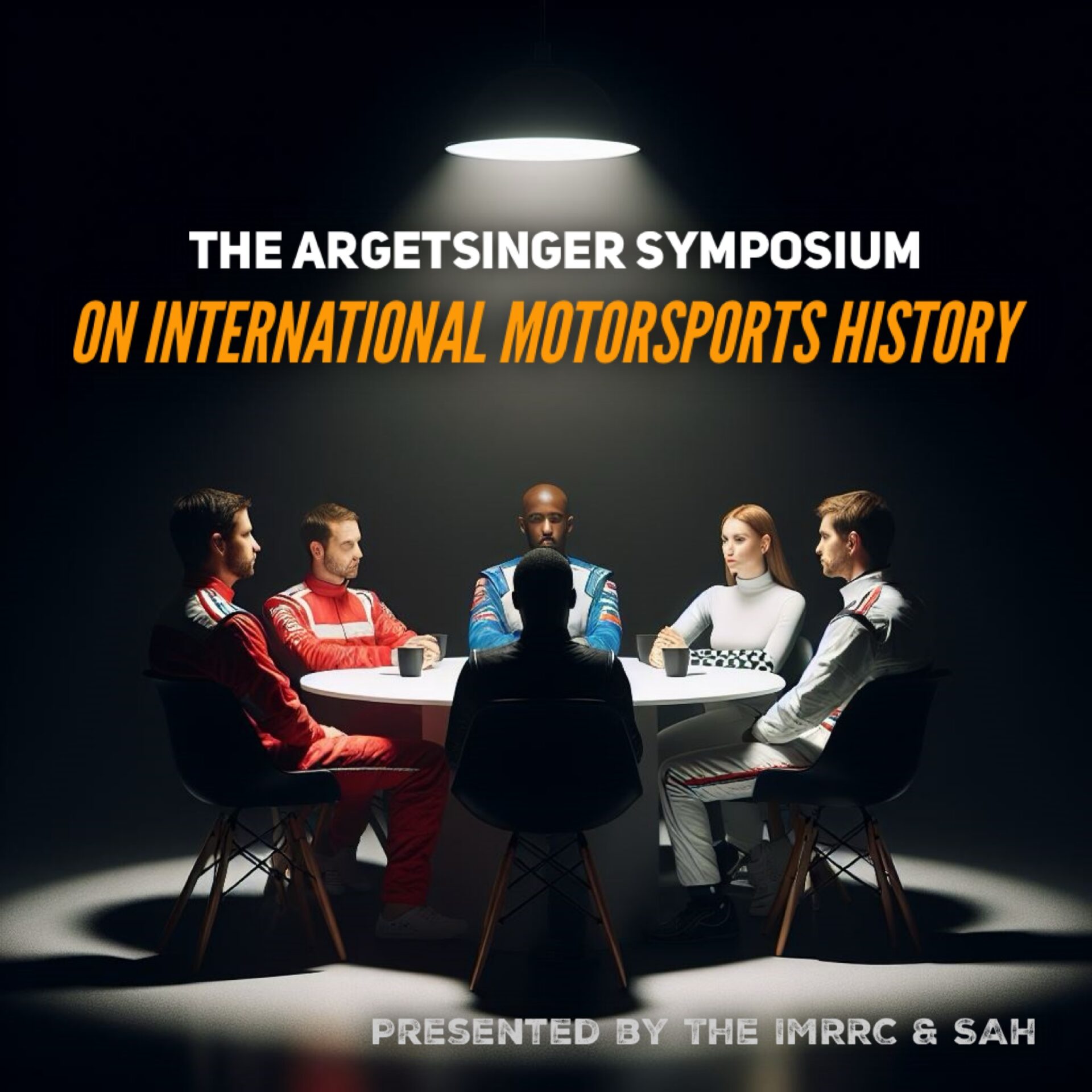 The International Motor Racing Research Center (IMRRC), partnering with the Society of Automotive Historians (SAH), presents the annual Michael R. Argetsinger Symposium on International Motor Racing History. The Symposium established itself as a unique and respected scholarly forum and has gained a growing audience of students and enthusiasts. It provides an opportunity for scholars, researchers and writers to present their work related to the history of automotive competition and the cultural impact of motor racing. Papers are presented by faculty members, graduate students and independent researchers.The history of international automotive competition falls within several realms, all of which are welcomed as topics for presentations, including, but not limited to: sports history, cultural studies, public history, political history, the history of technology, sports geography and gender studies, as well as archival studies.
The International Motor Racing Research Center (IMRRC), partnering with the Society of Automotive Historians (SAH), presents the annual Michael R. Argetsinger Symposium on International Motor Racing History. The Symposium established itself as a unique and respected scholarly forum and has gained a growing audience of students and enthusiasts. It provides an opportunity for scholars, researchers and writers to present their work related to the history of automotive competition and the cultural impact of motor racing. Papers are presented by faculty members, graduate students and independent researchers.The history of international automotive competition falls within several realms, all of which are welcomed as topics for presentations, including, but not limited to: sports history, cultural studies, public history, political history, the history of technology, sports geography and gender studies, as well as archival studies.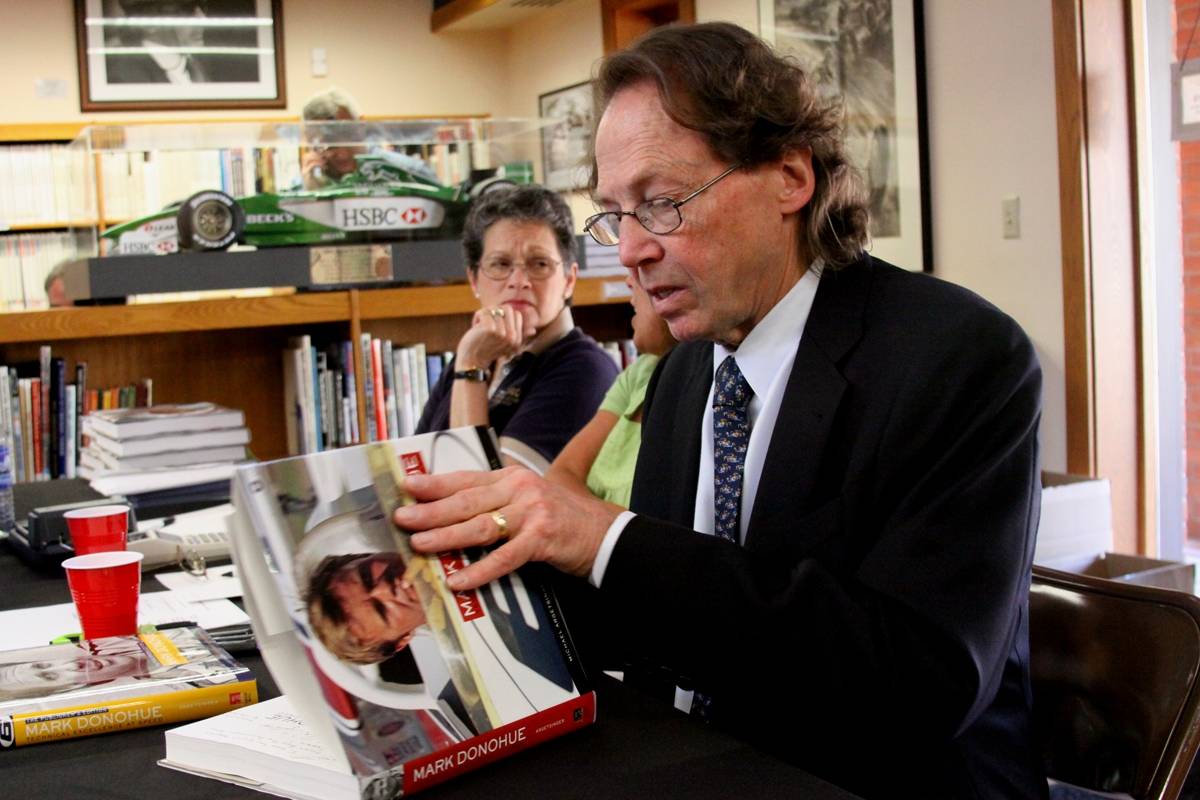 The symposium is named in honor of Michael R. Argetsinger (1944-2015), an award-winning motorsports author and longtime member of the Center's Governing Council. Michael's work on motorsports includes:
The symposium is named in honor of Michael R. Argetsinger (1944-2015), an award-winning motorsports author and longtime member of the Center's Governing Council. Michael's work on motorsports includes:- Walt Hansgen: His Life and the History of Post-war American Road Racing (2006)
- Mark Donohue: Technical Excellence at Speed (2009)
- Formula One at Watkins Glen: 20 Years of the United States Grand Prix, 1961-1980 (2011)
- An American Racer: Bobby Marshman and the Indianapolis 500 (2019)





